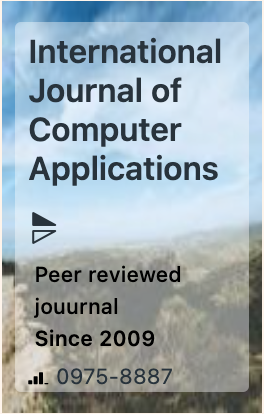The week's pick
Random Articles
Reseach Article
Prevalence and Family Dynamics of Internet Addiction Among Pre-Teens, Teenagers, and Adults in Bangladesh
| International Journal of Computer Applications |
| Foundation of Computer Science (FCS), NY, USA |
| Volume 186 - Number 48 |
| Year of Publication: 2024 |
| Authors: Kanan Chakraborty, Nayan Chakrabarty, Dhananjoy Chakraborty |
 10.5120/ijca2024924142
10.5120/ijca2024924142
|
Kanan Chakraborty, Nayan Chakrabarty, Dhananjoy Chakraborty . Prevalence and Family Dynamics of Internet Addiction Among Pre-Teens, Teenagers, and Adults in Bangladesh. International Journal of Computer Applications. 186, 48 ( Nov 2024), 26-34. DOI=10.5120/ijca2024924142
Abstract
Internet addiction in Bangladesh has become a pervasive effect, and the government is concerned about its impacts on families. The present study will investigate internet addiction among pre-teenagers, teenagers, and adults in Bangladesh and associated family dynamics. The objective of the present research study has been to examine the prevalence of internet addiction among pre-teens, teenagers, and adults in Bangladesh. Such analyses will be focused on age-specific differences in the prevalence and characteristics of internet addiction. Next, the study will explore the relationship between internet addiction and the quality of family communication and closeness. Finally, this paper will attempt to discuss possible gender differences in internet addiction for a comprehensive understanding of the phenomenon. This will be a cross-sectional study, using data through survey-based methods from 956 participants in three Bangladeshi administrative divisions. For this purpose, a multi-stage cluster sampling technique will be utilized to ensure representative samples are achieved. The self-administered questionnaires will cover the pattern of internet use, symptoms of internet addiction, and family dynamics. The study shall add to the growing understanding of the prevalence and influence of internet addiction on family relations in Bangladesh. This will detail the differences in age and gender to inform strategies for healthy internet use and family bonding.
References
- Hassan, T., Alam, M. M., Wahab, A., & Hawlader, M. D. (2020). Prevalence and associated factors of internet addiction among young adults in Bangladesh. Journal of the Egyptian Public Health Association, 95, 1-8.
- Ali, M. S., & Hossain, M. A. Physical and Psycho-Social Impact of Mobile Phone Usage among the High School Students of Rural Areas in Bangladesh.
- Jahan, S. M., Hossain, S. R., Sayeed, U. B., Wahab, A., Rahman, T., & Hossain, A. (2019). Association between internet addiction and sleep quality among students: a cross-sectional study in Bangladesh. Sleep and Biological Rhythms, 17, 323-329.
- Islam, M. A., & Hossin, M. Z. (2016). Prevalence and risk factors of problematic internet use and the associated psychological distress among graduate students of Bangladesh. Asian journal of gambling issues and public health, 6, 1-14.
- Islam, M. S., Sujan, M. S. H., Tasnim, R., Ferdous, M. Z., Masud, J. H. B., Kundu, S., ... & Griffiths, M. D. (2020). Problematic internet use among young and adult population in Bangladesh: Correlates with lifestyle and online activities during the COVID-19 pandemic. Addictive behaviors reports, 12, 100311.
- Kamal, S., & Arefin, M. S. (2016). Impact analysis of facebook in family bonding. Social Network Analysis and Mining, 6(1), 9.
- Hossain, A. (2017). The School-Level Factors Associated with Internet Ad-diction among Adolescents: Across-Sec-tional Study in Bangladesh.(2017) J Ad-dict Depend 3 (2): 170-174. Research Article Open Access.
- Chandrima, R. M., Kircaburun, K., Kabir, H., Riaz, B. K., Kuss, D. J., Griffiths, M. D., & Mamun, M. A. (2020). Adolescent problematic internet use and parental mediation: A Bangladeshi structured interview study. Addictive Behaviors Reports, 12, 100288.
- Islam, M. R., Apu, M. M. H., Akter, R., Tultul, P. S., Anjum, R., Nahar, Z., Shahriar, M., & Bhuiyan, M. A. (2023). Internet addiction and loneliness among school-going adolescents in Bangladesh in the context of the COVID-19 pandemic: Findings from a cross-sectional study. Heliyon, 9(2). https://doi.org/10.1016/j.heliyon.2023.e13340
- Lin M-P, Wu JY-W, You J, Hu W-H. Prevalence of internet addiction and its risk and protective factors in a representative sample of senior high school students in Taiwan. J Adolesc. 2018;62(1):38–46.
- de Vries HT, Nakamae T, Fukui K, Denys D, Narumoto J. Problematic internet use and psychiatric co-morbidity in a population of Japanese adult psychiatric patients. BMC Psychiatry. 2018;1:9.
- Alzayyat, A., Alzayyat, A., Bassam, I., Malkawi, B. S., Al-Smadi, S., Al-Momani, S. M., & Al-Shawabkeh, J. D. (2024). Internet Use Patterns, Internet Addiction, and Anxiety among Youth in Jordan: A Cross-sectional Study. Jordan Journal of Nursing Research, 1, 15.
- Modara F, Rezaee-Nour J, Sayehmiri N, Maleki F, Aghakhani N, Sayehmiri K, Rezaei-Tavirani M. Prevalence of Internet Addiction in Iran: A Systematic Review and Meta-analysis. Addict Health. 2017 Fall;9(4):243-252. PMID: 30574288; PMCID: PMC6294487.
- Shao YJ, Zheng T, Wang YQ, Liu L, Chen Y, Yao YS. Internet addiction detection rate among college students in the People's Republic of China: a meta-analysis. Child Adolesc Psychiatry Ment Health. 2018 May 25;12:25. doi: 10.1186/s13034-018-0231-6. PMID: 29849754; PMCID: PMC5970523.
- Tadpatrikar A, Sharma MK, Amudhan S, Desai G. The Prevalence and Correlates of Internet Addiction in India as Assessed by Young’s Internet Addiction Test: A Systematic Review and Meta-analysis. Indian Journal of Psychological Medicine. 2024;0(0). doi:10.1177/02537176241232110.
- Islam, M. R., Apu, M. M. H., Akter, R., Tultul, P. S., Anjum, R., Nahar, Z., Shahriar, M., & Bhuiyan, M. A. (2023). Internet addiction and loneliness among school-going adolescents in Bangladesh in the context of the COVID-19 pandemic: Findings from a cross-sectional study. Heliyon, 9(2). https://doi.org/10.1016/j.heliyon.2023.e13340.
Index Terms
Keywords

